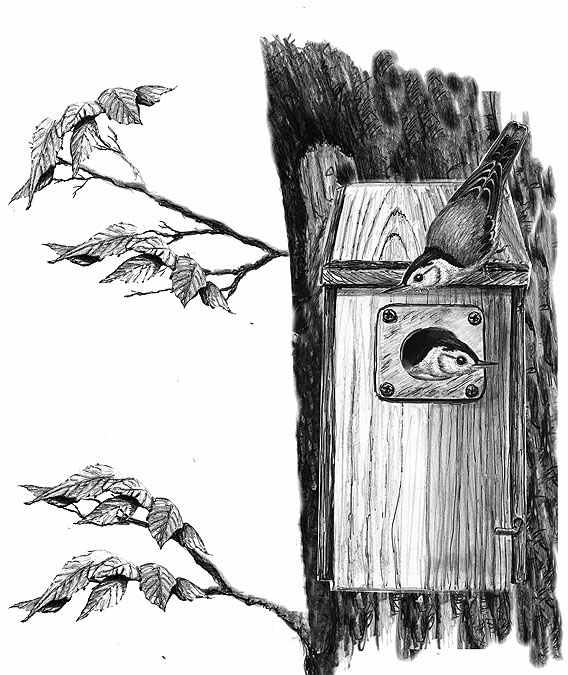
Dear Bird Folks,
I’m a faithful reader of your column, but I don’t recall that you have ever written about one of my favorite backyard birds, the White-breasted Nuthatch. Please tell me something about their behavior.
– Ralph, Dennis Port, MA
Thanks, Ralph,
It’s nice to hear you are a faithful reader. I’m glad somebody is. Although you aren’t as “faithful” as you claim because I have written about White-breasted Nuthatches before. I wrote a column about them back on April 29th, 2005. Remember, Tommy, from Rosewood, KY wrote in with a nuthatch question? No? How can you not remember? It was only ten years and 520 columns ago. It looks like someone needs to start paying attention. Just teasing you. The truth is, until I looked it up I didn’t even remember writing that column. But I’m glad you asked because they have to be mentioned more than once every ten years. If any bird needs to hire a new press agent, it’s the White-breasted Nuthatch.
White-breasted Nuthatches are like canned peas: they are always around, but for some reason no one (except you and Tommy, from Rosewood, KY) ever pays much attention to them. In fact, nuthatches are one of the few bird species that people are actually neutral about. We become downright giddy over hummingbirds, orioles and bluebirds or go into a rage at the sight of a crow, grackle or Blue Jay. Yet, I rarely hear a good word or a bad word about nuthatches. Are they just too bland to talk about? Hmm, let’s see what I can find to make these flying “canned peas” more interesting.
Let’s start with the obvious: Nuthatches have the rare ability to walk down tree trunks headfirst (which, if you haven’t tried it, is a really scary thing to do). This behavior alone should be enough to impress us. Even the much-adored bluebirds can’t do that, and neither can other tree trunk-loving birds like woodpeckers and Brown Creepers. Why do nuthatches walk down trees headfirst? Are they just showing off or do they enjoy the sensation of having blood rush to their heads? More likely it has to do with foraging. By walking down the tree, instead of up, nuthatches are able to discover hidden food that the upward climbing birds miss. To keep from tumbling to the ground, nuthatches grip the bark with the help of their strong legs, sharp claws and extra-long toes. (If you need your back scratched, this would be a good bird to ask.)
Here in eastern North America we have three species of nuthatches. There is the adorable Brown-headed Nuthatch (found in the Southeast), the chatty Red-breasted Nuthatch (that tends to live farther north) and your fave, the White-breasted. In addition, the western states have a fourth species, the Pygmy Nuthatch (which sounds like it should be politically incorrect to say, but apparently it’s okay). A few winters ago large numbers of Red-breasted Nuthatches invaded Cape Cod (and other areas) searching for food. A seed crop failure forced thousands of these little birds to move south, and the local pitch pine forests were alive with the sounds of noisy Red-breasted Nuthatches. However, such mass movements are less likely to happen with white-breasteds because they tend to remain in the same location year-round. In addition, these birds normally stay in pairs. So, unlike chickadees or finches, which come to our feeders in small flocks, you are apt to only see two white-breasts in your yard at one time. (I’m sure there was a better way to write that last sentence, but I left it in for you, Ralph.)
Because WBNU (that’s not a radio station; it’s cool birder talk for White-breasted Nuthatch) couples stay together throughout the year, they feel the need to stay in close contact as they forage. You’ll know when a pair is in the ‘hood because you’ll hear their distinctive “yank, yank, yank” call. But even devoted couples can only take so much of each other, so at night the birds sleep in separate roosting cavities. (It seems that constant “yank, yank, yank” gets old after a while.) In the morning, before they get together for breakfast, each bird cleans its roosting hole by carrying out any droppings that may have been deposited during the night. How about that? Now there’s a bird that knows proper etiquette.
The books say WBNU pairs build their nests in old woodpecker holes or natural tree cavities. The books also tell us that these birds rarely use birdhouses, but I’ve had several nuthatches use my nest boxes. And Rosewood KY’s famous Tommy also had a pair use his box. (See, you can’t believe everything you read.) He even described a phenomenon known as “bill sweeping.” Bill sweeping is when a nuthatch takes a crushed insect, or some other foreign substance, and wipes it around the cavity’s entrance. It’s a very odd and entertaining behavior to witness and scientists aren’t sure why the birds do it. They theorize that the smell of the crushed insect keeps predatory squirrels away. To this I say: Yeah, right. Sorry, eggheads. Take it from me, and every one of my customers, there ain’t no bug smell on earth, or anything else for that matter, that’s going to stop a hungry squirrel.
I agree with you, Ralph. White-breasted Nuthatches are fun and interesting backyard birds. They not only can walk down a tree headfirst, but they clean up their own poop. It’s too bad other creatures don’t do that. That’s right, I’m talking to you dogs of the world.